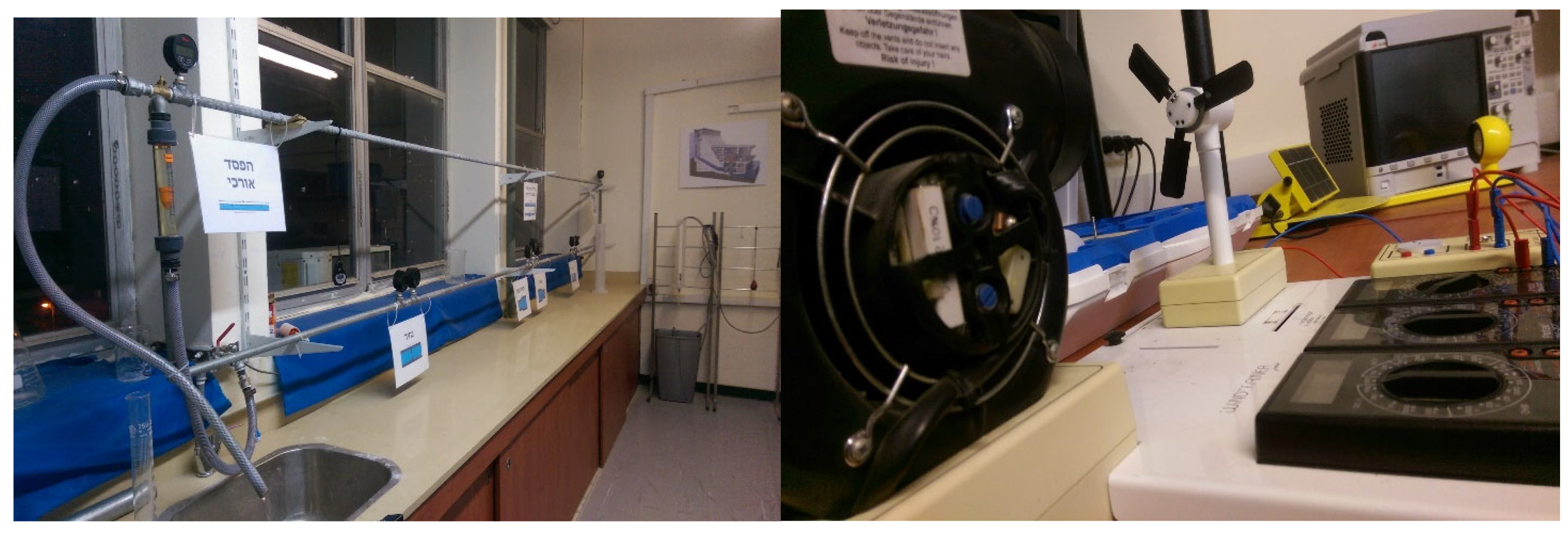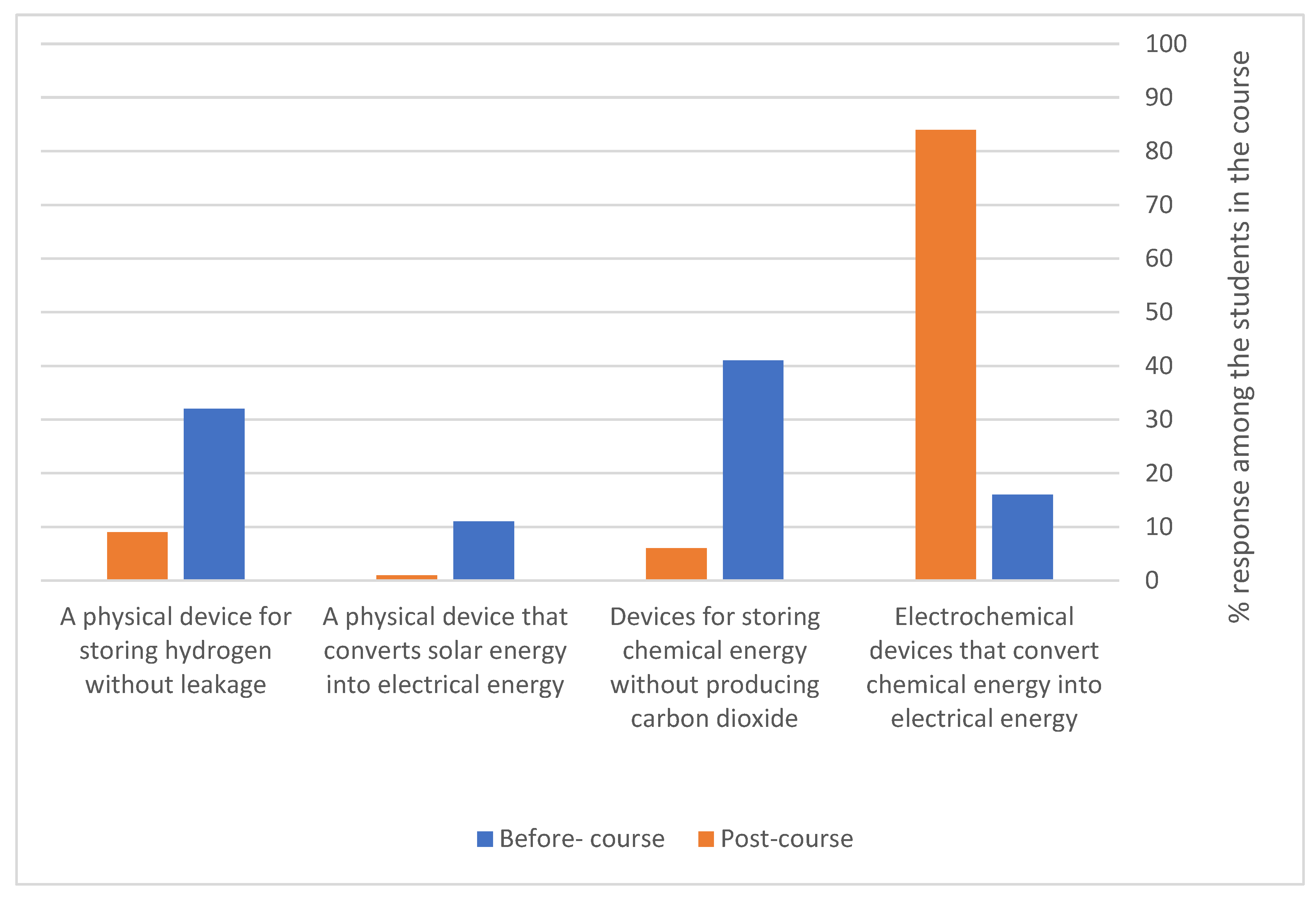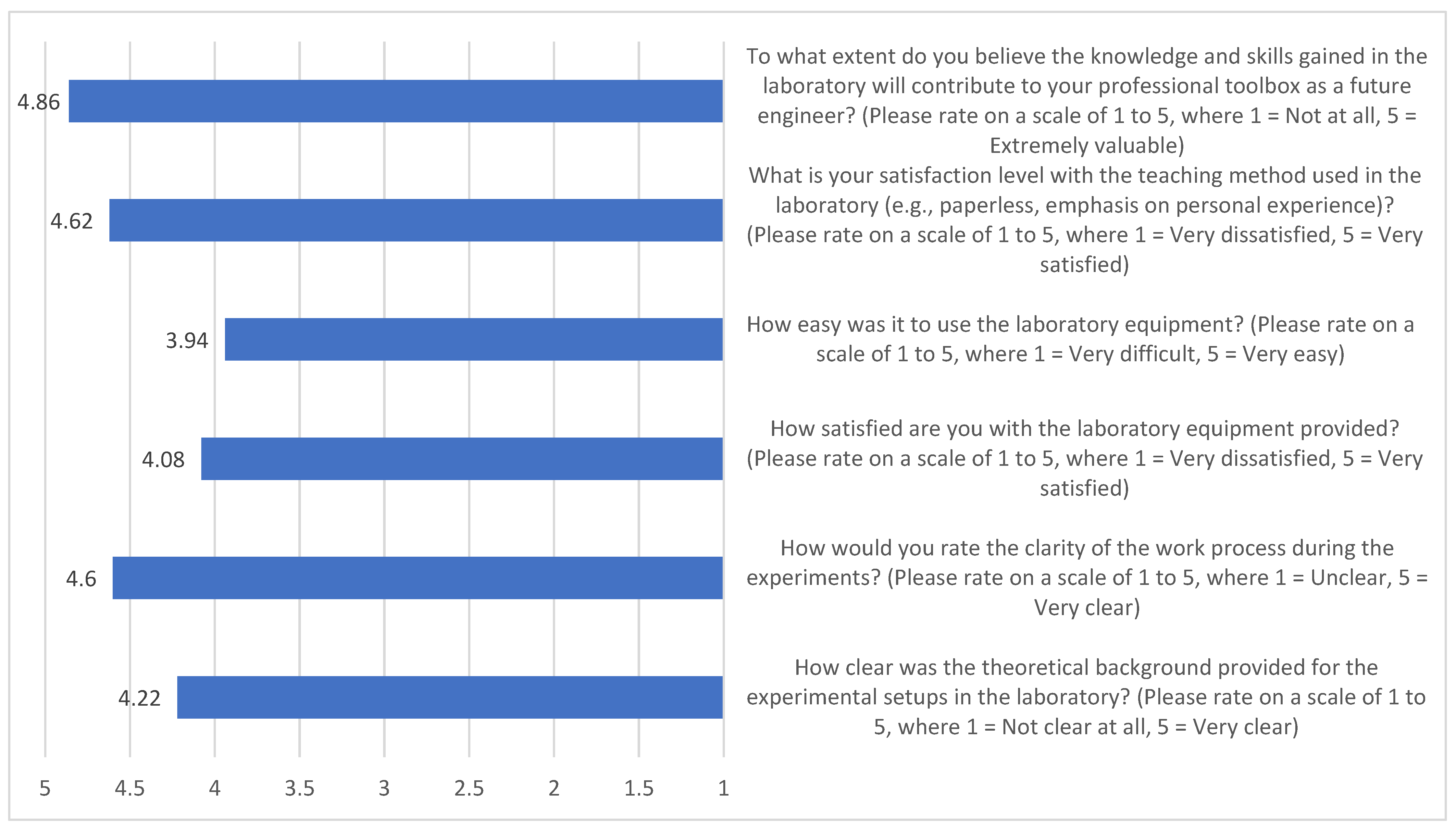Shaping the Engineers of Tomorrow: Integrating Renewable Energies and Advanced Technologies in Electrical and Electronics Engineering Education
Abstract
:1. Introduction
2. Trends in the Field of Energy
3. Application in Engineering Education
3.1. Professional and Innovative Courses in the Energy Field
3.2. Renewable Energy Laboratory
3.3. Hands-On Projects in the Energy Field
4. Results
5. Discussion
6. Conclusions
- The curriculum now balances traditional fossil energy sources with emerging renewable energy technologies, emphasizing the importance of smart grids.
- The introduction of specialized courses, such as the Renewable Energy and Smart Grid Business Entrepreneurship course, equips students with essential knowledge and practical tools for managing startups in green energy technology.
- The shift from traditional paper-based laboratory reports to practical laboratories focused on renewable energies fosters essential skills that are crucial for the renewable energy sector.
- A hybrid approach combining face-to-face lectures, industry expert discussions, and online courses ensures students receive a comprehensive educational experience, blending theoretical foundations with practical insights.
- The emphasis on project management, problem-solving, and teamwork through practical work with equipment and project execution prepares students to address real-world challenges.
- The introduction of additional elective courses in energy, renewable energy, and sustainability ensures the curriculum adapts to the evolving needs of the energy and environmental sectors.
Funding
Data Availability Statement
Conflicts of Interest
References
- Hans-Erik, E.; Tobias, B. The Impact of Environmental Education on Environmental and Renewable Energy Technology Awareness: Empirical Evidence from Colombia. Int. J. Sci. Math. Educ. 2020, 18, 611–634. [Google Scholar] [CrossRef]
- Flouros, F.; Roukanas, S.; Sklias, P. Energy Security and National Security: The Case of Israel. In The Political Economy of Development in Southeastern Europe. Contributions to Economics; Roukanas, S., Polychronidou, P., Karasavvoglou, A., Eds.; Springer: Cham, Switzerland, 2018. [Google Scholar] [CrossRef]
- Eitan, A. Promoting renewable energy to cope with climate change—Policy discourse in Israel. Sustainability 2021, 13, 3170. [Google Scholar] [CrossRef]
- Casini, M. Harvesting energy from in-pipe hydro systems at urban and building scale. Int. J. Smart Grid Clean Energy 2015, 4, 316–327. [Google Scholar] [CrossRef]
- Zhang, Z.; Hansen, C.T.; Andersen, M.A. Teaching power electronics with a design-oriented, project-based learning method at the Technical University of Denmark. IEEE Trans. Educ. 2015, 59, 32–38. [Google Scholar] [CrossRef]
- Wieser, A.; Buff Keller, E.; Graf, S. Integrating transferable skills into an existing curriculum: The example of Geospatial Engineering at ETH Zurich. ETH Learn. Teach. J. 2020, 2 (Suppl. S2), 281–286. [Google Scholar]
- Fernando, W.; Gupta, N.; Linn, H.H.; Ozveren, C.S. Design of optimum configuration of a hybrid power system for Abertay University campus. In Proceedings of the 2018 IEEE Conference of Russian Young Researchers in Electrical and Electronic Engineering (EIConRus), Moscow/St. Petersburg, Russia, 29 January–1 February 2018; IEEE: Piscataway, NJ, USA, 2018; pp. 1795–1800. [Google Scholar] [CrossRef]
- OECD Economics Department. Addressing Challenges in the Energy Sector in Israel; OECD Economics Department Working Papers, No. 914; OECD Publishing: Paris, France, 2011. [Google Scholar] [CrossRef]
- Levin, N.; Tishler, A.; Zahavi, J. Evaluating Energy Options for Israel: A Case Study. Energy J. 1986, 7, 51–66. [Google Scholar] [CrossRef]
- Bica, D.; Bucur, D.; Modrea, A. Current trends and challenges in power engineering education. Acta Marisiensis Ser. Technol. 2009, 6, 85. [Google Scholar]
- Egas, P.F.B.; Saltos, M.A.G.; Toasa, R. Application of Data Mining and Data Visualization in Strategic Management at Israel Technological University of Ecuador. 2020. Available online: https://www.researchgate.net/profile/Paul-Baldeon-Egas/publication/336496941_Application_of_Data_Mining_and_Data_Visualization_in_Strategic_Management_Data_at_Israel_Technological_University_of_Ecuador/links/5daef8844585155e27f7c7c0/Application-of-Data-Mining-and-Data-Visualization-in-Strategic-Management-Data-at-Israel-Technological-University-of-Ecuador.pdf (accessed on 7 July 2024).
- Kenett, R.S.; Swarz, R.S.; Zonnenshain, A. (Eds.) Systems Engineering in the Fourth Industrial Revolution: Big Data, Novel Technologies, and Modern Systems Engineering; John Wiley & Sons: Hoboken, NJ, USA, 2019. [Google Scholar]
- Solarz, J.; Gawlik-Kobylińska, M.; Ostant, W.; Maciejewski, P. Trends in energy security education with a focus on renewable and nonrenewable sources. Energies 2022, 15, 1351. [Google Scholar] [CrossRef]
- Martin-Gutierrez, J.; Guinters, E.; Perez-Lopez, D. Improving strategy of self-learning in engineering: Laboratories with augmented reality. Procedia-Soc. Behav. Sci. 2012, 51, 832–839. [Google Scholar] [CrossRef]
- Kose, U.; Arslan, A. Optimization of self-learning in Computer Engineering courses: An intelligent software system supported by Artificial Neural Network and Vortex Optimization Algorithm. Comput. Appl. Eng. Educ. 2017, 25, 142–156. [Google Scholar] [CrossRef]
- Samavedham, L.; Ragupathi, K. Facilitating 21st century skills in engineering students. J. Eng. Educ. 2012, 26, 38–49. [Google Scholar]
- Rusmayadi, G.; Supriandi, S.; Pahrijal, R. Trends and Impact of Sustainable Energy Technologies in Mechanical Engineering: A Bibliometric Study. West Sci. Interdiscip. Stud. 2023, 1, 843–853. [Google Scholar] [CrossRef]
- Kraytsberg, A.; Ein-Eli, Y. The State of Israel: Toward a Renewable Low-Carbon Energy Production. Energy Technol. 2022, 10, 2200122. [Google Scholar] [CrossRef]
- Friman, H. New Trends in the Higher Education: Renewable Energy at the Faculty of Electrical Engineering. Energy Procedia 2017, 115, 18–28. [Google Scholar] [CrossRef]
- Mor, A.; Seroussi, S.; Ainspan, M. Electricity and Renewable Energy—Israel Profile. In Renewable Energy in the Middle East. NATO Science for Peace and Security Series C: Environmental Security; Mason, M., Mor, A., Eds.; Springer: Dordrecht, The Netherlands, 2009. [Google Scholar] [CrossRef]
- Gero, A.; Friesel, A. Academic motivation in beginning students of electrical engineering: A case study of Danish and Israeli universities. Glob. J. Eng. Educ. 2020, 22, 204–209. [Google Scholar]
- Yezioro, A.; Capeluto, I.G. Energy rating of buildings to promote energy-conscious design in Israel. Buildings 2021, 11, 59. [Google Scholar] [CrossRef]
- Feisel, L.D.; Rosa, A.J. The Role of the Laboratory in Undergraduate Engineering Education. J. Eng. Educ. 2005, 94, 121–130. [Google Scholar] [CrossRef]
- Hu, A.; Mao, X.; Fu, C.; Wu, M.; Zhou, S. Engineering curriculum reform based on outcome-based education and five-color psychology theory. Sustainability 2023, 15, 8915. [Google Scholar] [CrossRef]
- Ayhan, B. Teacher opinions about children’s awareness of zero-waste and recycling in the pre-school education years. Rev. Int. Geogr. Educ. Online 2020, 10, 351–372. [Google Scholar] [CrossRef]
- Friman, H.; Banner, I.; Sitbon, Y.; Einav, Y.; Shaked, N. Preparing the Public Opinion in the Community to Accept Distributed Energy Systems and Renewable Energy. Energies 2022, 15, 4226. [Google Scholar] [CrossRef]
- Friman, H.; Banner, I.; Sitbon, Y.; Sahar-Inbar, L.; Shaked, N. Nurturing Eco-Literate Minds: Unveiling the Pathways to Minimize Ecological Footprint in Early Childhood Education. Soc. Sci. 2024, 13, 187. [Google Scholar] [CrossRef]
- Teschner, N.; McDonald, A.; Foxon, T.J.; Paavola, J. Integrated transitions toward sustainability: The case of water and energy policies in Israel. Technol. Forecast. Soc. Change 2012, 79, 457–468. [Google Scholar] [CrossRef]
- Suleiman, M.K.; Shahid, S.A. (Eds.) Strategies: A Review. In Terrestrial Environment and Ecosystems of Kuwait; Springer: Cham, Switzerland, 2024. [Google Scholar] [CrossRef]





Disclaimer/Publisher’s Note: The statements, opinions and data contained in all publications are solely those of the individual author(s) and contributor(s) and not of MDPI and/or the editor(s). MDPI and/or the editor(s) disclaim responsibility for any injury to people or property resulting from any ideas, methods, instructions or products referred to in the content. |
© 2024 by the author. Licensee MDPI, Basel, Switzerland. This article is an open access article distributed under the terms and conditions of the Creative Commons Attribution (CC BY) license (https://creativecommons.org/licenses/by/4.0/).
Share and Cite
Friman, H. Shaping the Engineers of Tomorrow: Integrating Renewable Energies and Advanced Technologies in Electrical and Electronics Engineering Education. Energies 2024, 17, 4146. https://doi.org/10.3390/en17164146
Friman H. Shaping the Engineers of Tomorrow: Integrating Renewable Energies and Advanced Technologies in Electrical and Electronics Engineering Education. Energies. 2024; 17(16):4146. https://doi.org/10.3390/en17164146
Chicago/Turabian StyleFriman, Hen. 2024. "Shaping the Engineers of Tomorrow: Integrating Renewable Energies and Advanced Technologies in Electrical and Electronics Engineering Education" Energies 17, no. 16: 4146. https://doi.org/10.3390/en17164146







